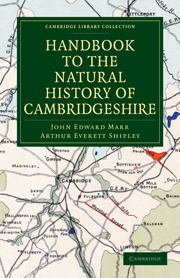VERTEBRATE PALÆONTOLOGY
Published online by Cambridge University Press: 10 November 2010
Summary
From the point of view of the student of vertebrate palaeontology Cambridge is an unusually interesting county, since it contains two deposits which are practically unique, although one extends to a certain degree into the adjacent counties. The first of these two deposits is the one at Barrington, yielding mammalian remains of Pleistocene age, remarkable for their perfect state of preservation and for the numbers in which they occur. It is this fine state of preservation and numerical abundance of the remains, coupled with the peculiar nature of the rock in which they are buried, which entitles the Barrington deposit to be called unique, for the species of mammals it contains are not different from those found elsewhere.
The second and more noteworthy fossiliferous deposit is the coprolite band of the Cambridge Greensand, which was so extensively worked for phosphates in the second third of the last century, but is now practically exhausted. From this deposit during the time that the coprolite diggings were in full swing vast quantities of vertebrate remains were secured by various energetic collectors, the greater number of which are preserved in the Cambridge Geological Museum. Unfortunately these remains are for the most part very fragmentary and much rolled and water-worn, so that their determination and association is generally a matter of extreme difficulty. But this is by no means the only unfortunate circumstance connected with these remains.
- Type
- Chapter
- Information
- Handbook to the Natural History of Cambridgeshire , pp. 51 - 70Publisher: Cambridge University PressPrint publication year: 2010First published in: 1904
- 1
- Cited by

